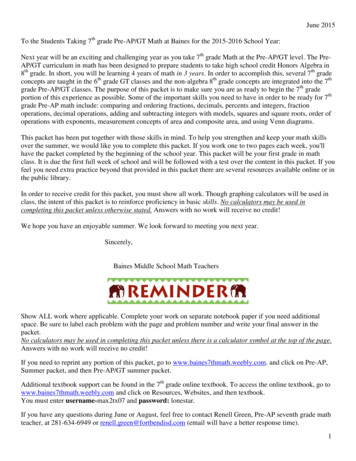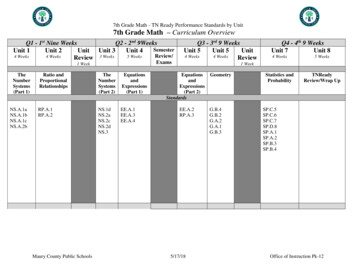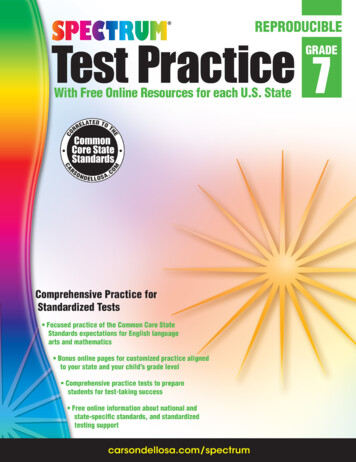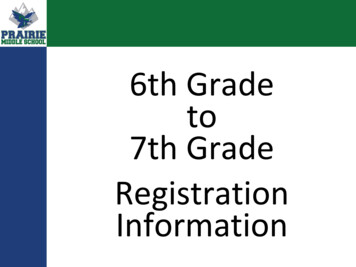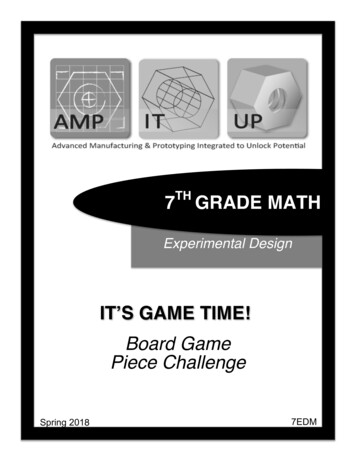
Transcription
7THGRADE MATHExperimental DesignIT’S GAME TIME!Board GamePiece ChallengeSpring 20187EDM
7th Grade Math Experimental Design (7EDM)It’s Game Time!Board Game Piece ChallengeModule DescriptionSupportedGeorgia Standards ofExcellenceModule TimelineDocumentsIncluded in the DownloadStudents use different measuring tools to find the dimensions of a set of 3-D printedgeometric solids to find the piece that best fits a set of requirements. Using themeasurements and formulas for basic geometric solids, they will then be asked tocalculate the values for area, surface area, and volume to compare the pieces in theirgroup’s set. They will present and/or write a letter that supports their decision for thegame piece that best fits all design requirements from their set. During the module,they will investigate experimental design as they create a procedure to measure theirpieces.MGSE7.G.4: Given the formulas for the area and circumference of a circle, use them tosolve problems; give an informal derivation of the relationship between thecircumference and area of a circle.MGSE7.G.6: Solve real-world and mathematical problems involving area, volume andsurface area of two- and three-dimensional objects composed of triangles,quadrilaterals, polygons, cubes, and right prisms.50-minute class periods:90 minute blocks:6 days3 daysDay 1: Section 1Day 1: Sections 1 & 2Day 2: Section 2Day 2: Sections 2 & 3Day 3: Section 2Day 3: Sections 3 & 4Day 4: Section 3Day 5: Section 3Day 6: Section 4Student Materials Folder Student Edition (recommended to be printed double sided) Student Worksheet Packet (recommended to be printed single sided)Teacher Materials Folder Materials List Annotated Teacher’s Edition Teacher’s Preparation Guide Video
5E StageEngageHow does the lesson capture studentinterest, activate prior knowledge, andconnect to a complex question, globalissue, or real-world problem?ExploreHow does the lesson allow students todevelop a common base of experiencesby actively investigating the phenomenonor problem?Student ActivitiesHow will students engage actively in the threedimensions throughout the lesson? Students are introduced to the challenge(determine the best design for a new game piece)(1.1)Teacher ActivitiesHow will the teacher facilitate and monitor studentlearning throughout the lesson? Guide students through text to check forunderstanding. Students will read from the test to familiarizethemselves with the design requirements. (1.1, 1.2)Students are given the 4-part sticker set and thesingle sticker that make up the visibilityrequirement. (1.1)Students analyze each design requirementindividually and answer questions on their DesignRequirement Student Sheet. (1.3)Through a class discussion, groups will share someof their idea for each requirement. (1.3)Students will complete their Geometric FormulasStudent Sheet needed to solve the challenge. (1.4) Students complete their Geometric FormulasStudent Sheet needed to solve the challenge. (1.4) Based on requirement testing results, studentmeasure and record the required measurementsneeded to calculate area, surface area, and volumeof game pieces on Game Piece Data Student Sheet# 1. (2.1) Students discuss whether the measuring tool thattheir group was initially assigned was difficult touse to determine measurements on some of thegeometric figures. (2.1) Students develop a testing procedure. (2,2, 2.3) Students accurately measure the figures andcalculate the area, surface area, and volume. (2.4) Students perform both physical tests and usemathematical computations to determine if theirgame pieces meet the requirements. (3) Students provide a written explanation includingstatements about the tests that they performed todetermine their design solution. (4)Formative: Ongoing questioning and discussion (all sections) Design Requirement Student Sheet (1.3) Geometric Formulas Student Sheet (1.4) Game Piece Student Sheet # 1(2.1) Testing Procedure Student Sheet (2.2, 2.3) Game Piece Student Sheet # 2 (2.4) Requirement Testing Student Sheet (3)Summative: Sharing Your Findings Student Sheet (4) ExplainHow does the lesson allow students todevelop, share, critique, and revise theirexplanations before connecting toscientific explanations and terminology?ElaborateHow does the lesson allow students toextend their conceptual understanding ofthe three dimensions throughopportunities to apply knowledge, skills,and abilities in new experiences?EvaluateHow does the lesson—through bothformative assessments embeddedthroughout the lesson and a summativeassessment that might coincide with theelaborate phase—make visible students’thinking and their ability to use practiceswith core ideas and crosscutting conceptsto make sense of phenomena and/or todesign 1.2 1.31.42.12.2 Divide students into groups of 3- 4.Facilitate a class discussion about theinformation required to make a good decision.Facilitate reading and monitor groupdiscussions while students explore therequirements.Facilitate class discussion where groups sharetheir ideas for each requirement.Allow time for student groups to discuss thegeometric formulas needed to complete thechallenge.Conduct a lesson on the geometric formulasneeded to complete the challenge.Monitor groups as the measure with theirassigned measuring tools. Check for accuracy.Facilitate a class discussion where studentsdiscuss their group’s measuring tool.Have groups share their testing procedures.Monitor groups as they work through theircalculations. Check for accuracy.Monitor groups as they work through theirRequirement Testing Student Sheet .Ensure students provide a written explanationincluding statements about the tests that theyperformed to determine their design solution.2.32.43.14.1
Section 1 – The Board Game Piece Design Challenge (50 minutes)Section 1 provides students with a background of the Board Game Piece Challenge where GriffinCraft, a new game producer,has asked the students to become part of a game piece design team. In Part 1.1, students will view the 3D Game Piece videoused as a hook for the challenge. In the challenge, students are given design requirements of stability, size, image visibility,and cost. Part 1.2 introduces students to the concept of a design solution which must meet certain design requirements or, atleast most of the design requirements. In Part 1.3, students begin analyzing the design requirements and deciding onprocedures used to test the pieces. In Part 1.4, the teacher conducts a lesson that provides students with the geometricformulas needed to solve the challenge.PreparationMaterials Video: 3D Game PieceStudent Pages Design Requirement Student Sheet Geometric Formulas Student SheetPrep the Day Before: Review the section and challenge. Review video. Review class discussion questions.PlanningGSECCSSMGSE7.G.4: Given the formulas for the area and circumference of a circle, use them to solve problems; give an informalderivation of the relationship between the circumference and area of a circle.MGSE7.G.6: Solve real-world and mathematical problems involving area, volume and surface area of two- and threedimensional objects composed of triangles, quadrilaterals, polygons, cubes, and right prisms.CCSS.MATH.CONTENT.7.G.B.4: Know the formulas for the area and circumference of a circle and use them to solveproblems; give an informal derivation of the relationship between the circumference and area of a circle.CCSS.MATH.CONTENT.7.G.B.6: Solve real-world and mathematical problems involving area, volume and surface area oftwo- and three-dimensional objects composed of triangles, quadrilaterals, polygons, cubes, and right prisms.Key Terms and Concepts Design solutionAreaSurface areaBaseEssential Questions What is a design solution?How do we determine the area of thebase of a geometric figure?How do we determine the surfacearea of a geometric figure?Assessment and GradingOpportunities Discussion Questions:Participation Design Requirement StudentSheet: Formative Geometric Formulas StudentSheet: Formative
Section 2 – Testing the Game Pieces (100 minutes)For students to test the game pieces, they will need to calculate the area, surface area, and volume of each of thepieces. To do so, they much accurately measure their pieces with the measuring tool that their group has beenassigned. Each group will receive either a ruler, a measuring tape, or a set of calipers. In Part 2.1, using theirassigned measuring tool, students will measure and record their measurements on Game Piece Student Sheet # 1.In Part 2.2, student understand that a testing procedure is a series of steps used to determine if their piece meetsthe design requirements. The steps must be conducted accurately and consistently for their data to be accurate.Groups are now given all three measuring devices and students can determine the best tool to use for each figure.In Part 2.3, students develop a detailed set of procedures to measure the height of each game piece using thecalipers. In Part 2.4, using the tool that was decided to be the best, students will re-measure each geometricdimension need for their calculations and record it on Game Piece Student Sheet # 2. They will then compute thearea, surface area, and volume of each game piece.PreparationMaterials Sets of Game Pieces (1 set per group) Sets of Stickers (1 set per group) Measurement tools (differing among the groups)Prep the Day Before: Review the section and challenge. Review class discussion questions.Student Pages Game Piece Student Sheet # 1 Testing Procedure Student Sheet Game Piece Student Sheet # 2PlanningGSECCSSMGSE7.G.4: Given the formulas for the area and circumference of a circle, use them to solve problems; give an informalderivation of the relationship between the circumference and area of a circle.MGSE7.G.6: Solve real-world and mathematical problems involving area, volume and surface area of two- and threedimensional objects composed of triangles, quadrilaterals, polygons, cubes, and right prisms.CCSS.MATH.CONTENT.7.G.B.4: Know the formulas for the area and circumference of a circle and use them to solveproblems; give an informal derivation of the relationship between the circumference and area of a circle.CCSS.MATH.CONTENT.7.G.B.6: Solve real-world and mathematical problems involving area, volume and surface area oftwo- and three-dimensional objects composed of triangles, quadrilaterals, polygons, cubes, and right prisms.Key Terms and Concepts AccurateConsistentEssential Questions How can we develop a testingprocedure that will result inaccurate and consistent data?Assessment and Grading Opportunities Discussion Questions: ParticipationGame Piece Student Sheet # 1: FormativeTesting Procedure Student Sheet: FormativeGame Piece Student Sheet # 2: Formative
Section 3 –Testing the Design Requirements (100 minutes)Now students have all the measurements and formulas needed to test whether their game pieces meet the designrequirements. They can use both physical tests and mathematical computations to make their determinations.They will record all their data on their Requirement Testing Student Sheet. Students will also learn to use thestability inequality test. Pieces fail this stability test if the perimeter/circumference of the base of the figure is lessthat the height of the figure.PreparationMaterials N/AStudent Pages Requirement Testing Student SheetPrep the Day Before: Review the section and challenge. Review class discussion questions.PlanningGSECCSSMGSE7.G.4: Given the formulas for the area and circumference of a circle, use them to solve problems; give aninformal derivation of the relationship between the circumference and area of a circle.MGSE7.G.6: Solve real-world and mathematical problems involving area, volume and surface area of two- andthree-dimensional objects composed of triangles, quadrilaterals, polygons, cubes, and right prisms.CCSS.MATH.CONTENT.7.G.B.4: Know the formulas for the area and circumference of a circle and use them tosolve problems; give an informal derivation of the relationship between the circumference and area of a circle.CCSS.MATH.CONTENT.7.G.B.6: Solve real-world and mathematical problems involving area, volume and surfacearea of two- and three-dimensional objects composed of triangles, quadrilaterals, polygons, cubes, and rightprisms.Key Terms and Concepts AreaSurface areaVolumeStability inequalityAssessment and GradingOpportunitiesEssential Questions How do we determine the area andsurface area of a geometric figure?How do we determine the volume ofa geometric figure?How do we determine if a figure failsthe stability inequality test? Discussion Questions:ParticipationRequirement TestingStudent Sheet: Formative
Section 4 – Communicate Your Results (40 minutes)Students will write a letter or make a presentation to share their design solution with the design team using theSharing Your Findings Student Sheet. They will, not only present their solution, but also include statements aboutthe tests that they performed and their results as compared to the pieces that were not selected. They should fullyexplain their recommendation and give justification using their data.PreparationMaterials N/APrep the Day Before: Review the section and challenge.Student Pages Sharing Your Findings Student SheetPlanningGSECCSSMGSE7.G.4: Given the formulas for the area and circumference of a circle, use them to solve problems; give an informalderivation of the relationship between the circumference and area of a circle.MGSE7.G.6: Solve real-world and mathematical problems involving area, volume and surface area of two- and threedimensional objects composed of triangles, quadrilaterals, polygons, cubes, and right prisms.CCSS.MATH.CONTENT.7.G.B.4: Know the formulas for the area and circumference of a circle and use them to solveproblems; give an informal derivation of the relationship between the circumference and area of a circle.CCSS.MATH.CONTENT.7.G.B.6: Solve real-world and mathematical problems involving area, volume and surface area oftwo- and three-dimensional objects composed of triangles, quadrilaterals, polygons, cubes, and right prisms.Key Terms and ConceptsEssential Questions Design solutionHow can we determine and accuratelyjustify design solutions?Assessment and Grading Opportunities Class Discussion Question:ParticipationSharing Your Findings StudentSheet: Summative
This curriculum is produced by Advanced Manufacturing &Prototyping Integrated to Unlock Potential (AMP-IT-UP)supported by National Science Foundation Award #1238089through Georgia Institute of Technology’s Center for EducationIntegrating Science, Mathematics, and Computing (CEISMC).For more information about AMP-IT-UPand to download our curriculum,please visit our website at www.ampitup.gatech.edu.Copyright Georgia Institute of Technology All Rights Reserved 2017
7TH GRADE MATH Spring 2018 7EDM IT’S GAME TIME! Board Game Piece Challenge . 7th Grade Math Experimental Design (7EDM) . 90 minute blocks: 3 days Day 1: Sections 1 & 2 Day 2:
